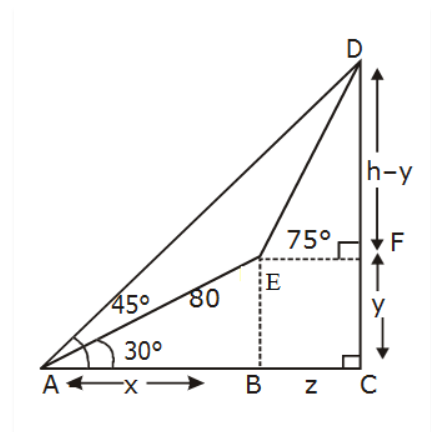
The angle of elevation of the top of a hill from a point on the horizontal plane passing through the foot of the hill is found to be ${{45}^{\circ }}$. After walking a distance of $80$ meters towards the top, up a slope inclined at an angle of ${{30}^{\circ }}$ to the horizontal plane, the angle of elevation of the top of the hill becomes $75^{\circ}$. Then the height of the hill (in meters) is:
Answer
218.7k+ views
Hint: In order to solve the question we will first make the diagram by using all the information given in the question then we will introduce some of the variables such as x,y,z and h and after that we will use trigonometric identities of cos x , sin x and tan x so that we can find the height of the hill (in meters)
Formula Used:
$\left[ \cos x=\dfrac{Base}{Hypotenuse} \right]$
$\left[ \sin x=\dfrac{Perpendicular}{Hypotenuse} \right]$
$\left[ \tan x=\dfrac{Perpendicular}{Base} \right]$
Complete step by step solution:
Let the height of the hill be $h$ meters.

Image: Right angled triangle
In $\Delta ABE$, we have
$\cos {{30}^{\circ }}=\dfrac{x}{80}$ $\left[ \cos x=\dfrac{Base}{Hypotenuse} \right]$
$\Rightarrow x=80\times \cos {{30}^{\circ }}$
We know that $\cos {{30}^{\circ }}=\dfrac{\sqrt{3}}{2}$, we get
$\Rightarrow x=80\times \dfrac{\sqrt{3}}{2}$
$\Rightarrow x=40\sqrt{3}\,m$
And,
$\sin {{30}^{\circ }}=\dfrac{y}{80}$ $\left[ \sin x=\dfrac{Perpendicular}{Hypotenuse} \right]$
$\Rightarrow y=80\times \sin {{30}^{\circ }}$
We know that $\sin {{30}^{\circ }}=\dfrac{1}{2}$, we get
$\Rightarrow y=80\times \dfrac{1}{2}$
$\Rightarrow y=40\,m$
In $\Delta ADC$, we have
$\tan {{45}^{\circ }}=\dfrac{h}{x+z}$ $\left[ \tan x=\dfrac{Perpendicular}{Base} \right]$
We know that $\tan {{45}^{\circ }}=1$. Therefore, we get
$\Rightarrow 1=\dfrac{h}{x+z}$
$\Rightarrow h=x+z$
Now substitute the value of $x$
$\Rightarrow h=40\sqrt{3}+z\,\,\,\,........\left( i \right)$
In $\Delta EDF$, we have
$\tan {{75}^{\circ }}=\dfrac{h-y}{z}$ $\left[ \tan x=\dfrac{Perpendicular}{Base} \right]$
We know that $\tan {{75}^{\circ }}=2+\sqrt{3}$. Therefore, we get
$\Rightarrow 2+\sqrt{3}=\dfrac{h-y}{z}$
$\Rightarrow z=\dfrac{h-y}{2+\sqrt{3}}$
Now, substitute the value of $y$
$\Rightarrow z=\dfrac{h-40}{2+\sqrt{3}}$
Now, put the value of $z$ in equation $\left( i \right)$
$\Rightarrow h=40\sqrt{3}+\dfrac{h-40}{2+\sqrt{3}}$
Take L.C.M.
$\Rightarrow h=\dfrac{40\sqrt{3}\left( 2+\sqrt{3} \right)+h-40}{2+\sqrt{3}}$
$\Rightarrow h=\dfrac{80\sqrt{3}+120+h-40}{2+\sqrt{3}}$
On cross multiplication, we get
$\Rightarrow h\left( 2+\sqrt{3} \right)=80\sqrt{3}+80+h$
$\Rightarrow h\left( 2+\sqrt{3} \right)-h=80\sqrt{3}+80$
On subtraction of like terms, we get
$\Rightarrow 2h+\sqrt{3}h-h=80\sqrt{3}+80$
On subtraction, we get
$\Rightarrow h+\sqrt{3}h=80+80\sqrt{3}$
$\Rightarrow h\left( 1+\sqrt{3} \right)=80\left( 1+\sqrt{3} \right)$
On canceling the common terms, we get
$\Rightarrow h=80\,m$
Hence, the height of the hill is $80\,m$.
Note: The difference between an angle of depression and an angle of elevation is that the latter refers to the angle between the horizontal and the object. Applying the idea of trigonometric functions is made easier by realising that the structure and the lighthouse form right angled triangles. It is required to be familiar with the trigonometric table of the tan function.
Formula Used:
$\left[ \cos x=\dfrac{Base}{Hypotenuse} \right]$
$\left[ \sin x=\dfrac{Perpendicular}{Hypotenuse} \right]$
$\left[ \tan x=\dfrac{Perpendicular}{Base} \right]$
Complete step by step solution:
Let the height of the hill be $h$ meters.

Image: Right angled triangle
In $\Delta ABE$, we have
$\cos {{30}^{\circ }}=\dfrac{x}{80}$ $\left[ \cos x=\dfrac{Base}{Hypotenuse} \right]$
$\Rightarrow x=80\times \cos {{30}^{\circ }}$
We know that $\cos {{30}^{\circ }}=\dfrac{\sqrt{3}}{2}$, we get
$\Rightarrow x=80\times \dfrac{\sqrt{3}}{2}$
$\Rightarrow x=40\sqrt{3}\,m$
And,
$\sin {{30}^{\circ }}=\dfrac{y}{80}$ $\left[ \sin x=\dfrac{Perpendicular}{Hypotenuse} \right]$
$\Rightarrow y=80\times \sin {{30}^{\circ }}$
We know that $\sin {{30}^{\circ }}=\dfrac{1}{2}$, we get
$\Rightarrow y=80\times \dfrac{1}{2}$
$\Rightarrow y=40\,m$
In $\Delta ADC$, we have
$\tan {{45}^{\circ }}=\dfrac{h}{x+z}$ $\left[ \tan x=\dfrac{Perpendicular}{Base} \right]$
We know that $\tan {{45}^{\circ }}=1$. Therefore, we get
$\Rightarrow 1=\dfrac{h}{x+z}$
$\Rightarrow h=x+z$
Now substitute the value of $x$
$\Rightarrow h=40\sqrt{3}+z\,\,\,\,........\left( i \right)$
In $\Delta EDF$, we have
$\tan {{75}^{\circ }}=\dfrac{h-y}{z}$ $\left[ \tan x=\dfrac{Perpendicular}{Base} \right]$
We know that $\tan {{75}^{\circ }}=2+\sqrt{3}$. Therefore, we get
$\Rightarrow 2+\sqrt{3}=\dfrac{h-y}{z}$
$\Rightarrow z=\dfrac{h-y}{2+\sqrt{3}}$
Now, substitute the value of $y$
$\Rightarrow z=\dfrac{h-40}{2+\sqrt{3}}$
Now, put the value of $z$ in equation $\left( i \right)$
$\Rightarrow h=40\sqrt{3}+\dfrac{h-40}{2+\sqrt{3}}$
Take L.C.M.
$\Rightarrow h=\dfrac{40\sqrt{3}\left( 2+\sqrt{3} \right)+h-40}{2+\sqrt{3}}$
$\Rightarrow h=\dfrac{80\sqrt{3}+120+h-40}{2+\sqrt{3}}$
On cross multiplication, we get
$\Rightarrow h\left( 2+\sqrt{3} \right)=80\sqrt{3}+80+h$
$\Rightarrow h\left( 2+\sqrt{3} \right)-h=80\sqrt{3}+80$
On subtraction of like terms, we get
$\Rightarrow 2h+\sqrt{3}h-h=80\sqrt{3}+80$
On subtraction, we get
$\Rightarrow h+\sqrt{3}h=80+80\sqrt{3}$
$\Rightarrow h\left( 1+\sqrt{3} \right)=80\left( 1+\sqrt{3} \right)$
On canceling the common terms, we get
$\Rightarrow h=80\,m$
Hence, the height of the hill is $80\,m$.
Note: The difference between an angle of depression and an angle of elevation is that the latter refers to the angle between the horizontal and the object. Applying the idea of trigonometric functions is made easier by realising that the structure and the lighthouse form right angled triangles. It is required to be familiar with the trigonometric table of the tan function.
Recently Updated Pages
The maximum number of equivalence relations on the-class-11-maths-JEE_Main

A train is going from London to Cambridge stops at class 11 maths JEE_Main

Find the reminder when 798 is divided by 5 class 11 maths JEE_Main

An aeroplane left 50 minutes later than its schedu-class-11-maths-JEE_Main

A man on the top of a vertical observation tower o-class-11-maths-JEE_Main

In an election there are 8 candidates out of which class 11 maths JEE_Main

Trending doubts
JEE Main 2026: Application Form Open, Exam Dates, Syllabus, Eligibility & Question Papers

Derivation of Equation of Trajectory Explained for Students

Hybridisation in Chemistry – Concept, Types & Applications

Understanding the Angle of Deviation in a Prism

Understanding Collisions: Types and Examples for Students

Understanding Atomic Structure for Beginners

Other Pages
JEE Advanced Marks vs Ranks 2025: Understanding Category-wise Qualifying Marks and Previous Year Cut-offs

NCERT Solutions for Class 11 Maths Chapter 10 Conic Sections

NCERT Solutions for Class 11 Maths Chapter 9 Straight Lines

NCERT Solutions For Class 11 Maths Chapter 8 Sequences And Series

How to Convert a Galvanometer into an Ammeter or Voltmeter

NCERT Solutions For Class 11 Maths Chapter 12 Limits And Derivatives




